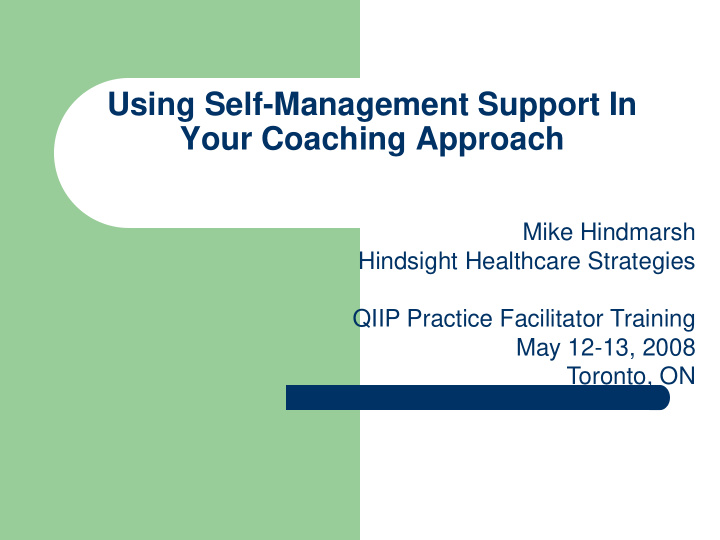



Using Self-Management Support In Your Coaching Approach Mike Hindmarsh Hindsight Healthcare Strategies QIIP Practice Facilitator Training May 12-13, 2008 Toronto, ON
Chronic Care Model Community Health System Health Care Organization Resources and Policies Clinical Self- Delivery Decision Information Management System Support Systems Support Design Prepared, Informed, Productive Proactive Activated Interactions Practice Team Patient Improved Outcomes
Self-Management Support Emphasize the patient’s central role in managing their illness Use effective self-management strategies that include assessment, goal-setting, action planning problem-solving and follow-up. Organize internal and community resources to provide ongoing self-management support to patients.
What is self-management? “ The individual’s ability to manage the symptoms, treatment, physical and social consequences and lifestyle changes inherent in living with a chronic condition.” Barlow et al, Patient Educ Couns 2002;48:177
Patient educ. vs. SMS Information and skills are Skills to solve pt. Identified taught problems are taught Usually disease-specific Skills are generalizable Assumes that knowledge Assumes that confidence creates behavior change yields better outcomes Goal is compliance Goal is increased self- efficacy Health care professionals are the teachers Teachers can be professionals or peers
Self-Management Tasks in Chronic Illness To take care of the illness To carry out normal activities To manage emotional changes Based on work by Corbin and Straus
Collaborative care “If physicians view themselves as experts whose job is to get patients to behave in ways that reflect that expertise, both will continue to be frustrated…Once physicians recognize patients as experts on their own lives, they can add their medical expertise to what patients know about themselves to create a plan that will help patients achieve their goals.” Funnell & Anderson JAMA 2000;284:1709
What self-management support isn’t... Didactic interaction Sage on the stage You should… Finger wagging Lecturing Waiting for patients to ask for help
Sel Self-Mana anagem ement i nt in n CCM ASSESS SSESS : Belie eliefs, Beh ehavior & & Knowledg ledge ARRANGE : : ADVIS ISE : E : Spec pecif ify plan plan for Provid ide sp specif ecific fol ollow ow-up (e (e.g., visits visits, Inf nfor ormation on a about out phone calls ph calls, m mailed ailed healt ealth r risk isks an s and Per ersonal Actio ction P Plan lan remin inder ers ben benef efit its of chan ange 1. 1. List ist specif specific g goals als in in beh behavio ioral ter terms 2. List 2. ist bar barrie iers an and d str strategie ies to to ad addr dress bar barrier iers 3. Spec 3. pecif ify F Follo llow-up P p Plan lan 4. 4. Shar are p plan lan with with pr practi actice team team an and d pa patien tient’s so social cial su supp pport ASSIS SSIST : AGR GREE: E: Iden dentif ify per perso sonal al Colla llabo boratively ly set set bar barrie iers, str strategie ies, pr problem lem-sol olving goals als based based o on pa patien tient’s techniq tec iques an and d inter in terest an and d co confid idence e social/ al/en environmen ental l in in th their eir ability bility to to c chan ange supp su pport the beh th e behavior Glasgow RE, et al (2002) Ann Beh Med 24(2):80-87
Using the Five A’s as a Facilitator
ASSESS Risk factors, Beliefs, Behavior and Knowledge
Tips on assessing your practice team Ask questions about them….get to “know” them Provide feedback to team when appropriate Assess their view of QI progress and how easy/difficult it is to get things done.
ADVISE Provide specific information about the benefits of practice change
Tips on providing advice Make the source of advice clear (medical knowledge or best practice) Personalize advice to the FHT/CHC environment Listen more than you talk Have a key message for each idea you present Don’t overwhelm them with information
AGREE Foster collaboration in selecting ideas for change.
Tips to create agreement Base goals and measures and team’s priorities Let then start where they want Do not judge ideas for change Do not make them agree with you Team consensus on testing ideas is not critical unless there is obvious opposition or discomfort
ASSIST Using behavior change techniques (problem solving, counseling) to aid the team in acquiring skills, confidence to test ideas quickly.
Tips on assisting patients Use other teams as examples Address helplessness Learn and use a problem-solving approach Link to the assessment of barriers and environment Avoid telling them what to do Avoid speeches Avoid cheerleading
Problem Solving 1. Identify the problem. 2. List all possible solutions. 3. Pick one. 4. Try it in the next testing cycle. 5. If it doesn’t work, try another. 6. If that doesn’t work, find a resource for ideas. 7. If that doesn’t work, accept that the problem may not be solvable now.
Thoughts on Team QI Literacy People can read and function above their cognitive level on topics that interest them People are very sensitive about being talked down to. Be cognizant of power inequities among team members
ARRANGE Schedule follow-up contacts to provide ongoing assistance and support as needed.
Tips for follow-up Try a wide variety of methods, whichever team prefers (in person, phone, email) Make sure follow-up happens, team trust can be destroyed by missed follow-up Determine follow-up based on team preference
Personal Action Plan 1. Something you WANT to do 2. Describe How Where What Frequency When 3. Barriers 4. Plans to overcome barriers 5. Confidence rating (1-10) 6. Follow-Up plan Source: Lorig et al, 2001
Confidence Ruler 1 2 3 4 5 6 7 8 9 10 Not Unsure Somewhat Very Confident Confident Confident
For More Information on Self-management Support www.improvingchroniccare.org thanks
Recommend
More recommend